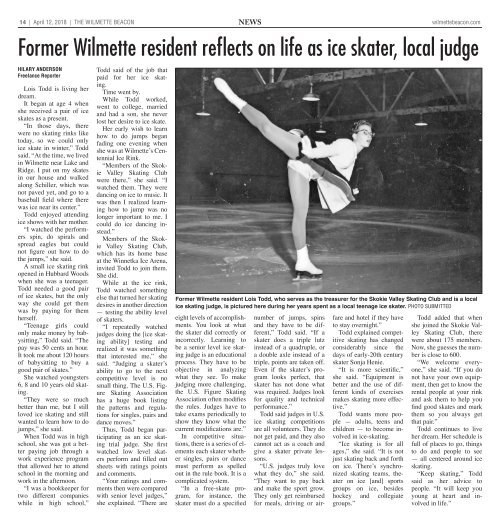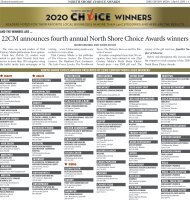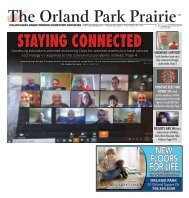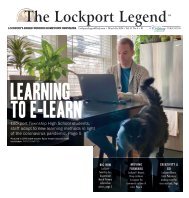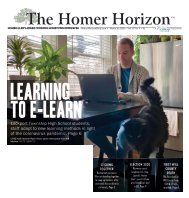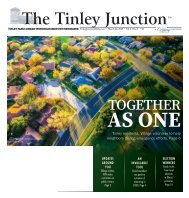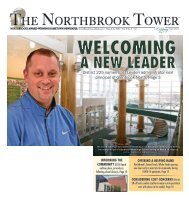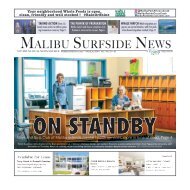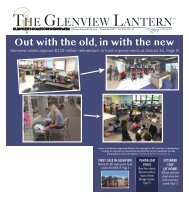WB_041218
The Wilmette Beacon 041218
The Wilmette Beacon 041218
You also want an ePaper? Increase the reach of your titles
YUMPU automatically turns print PDFs into web optimized ePapers that Google loves.
14 | April 12, 2018 | The wilmette beacon news<br />
wilmettebeacon.com<br />
Former Wilmette resident reflects on life as ice skater, local judge<br />
Hilary Anderson<br />
Freelance Reporter<br />
Lois Todd is living her<br />
dream.<br />
It began at age 4 when<br />
she received a pair of ice<br />
skates as a present.<br />
“In those days, there<br />
were no skating rinks like<br />
today, so we could only<br />
ice skate in winter,” Todd<br />
said. “At the time, we lived<br />
in Wilmette near Lake and<br />
Ridge. I put on my skates<br />
in our house and walked<br />
along Schiller, which was<br />
not paved yet, and go to a<br />
baseball field where there<br />
was ice near its center.”<br />
Todd enjoyed attending<br />
ice shows with her mother.<br />
“I watched the performers<br />
spin, do spirals and<br />
spread eagles but could<br />
not figure out how to do<br />
the jumps,” she said.<br />
A small ice skating rink<br />
opened in Hubbard Woods<br />
when she was a teenager.<br />
Todd needed a good pair<br />
of ice skates, but the only<br />
way she could get them<br />
was by paying for them<br />
herself.<br />
“Teenage girls could<br />
only make money by babysitting,”<br />
Todd said. “The<br />
pay was 50 cents an hour.<br />
It took me about 120 hours<br />
of babysitting to buy a<br />
good pair of skates.”<br />
She watched youngsters<br />
6, 8 and 10 years old skating.<br />
“They were so much<br />
better than me, but I still<br />
loved ice skating and still<br />
wanted to learn how to do<br />
jumps,” she said.<br />
When Todd was in high<br />
school, she was got a better<br />
paying job through a<br />
work experience program<br />
that allowed her to attend<br />
school in the morning and<br />
work in the afternoon.<br />
“I was a bookkeeper for<br />
two different companies<br />
while in high school,”<br />
Todd said of the job that<br />
paid for her ice skating.<br />
Time went by.<br />
While Todd worked,<br />
went to college, married<br />
and had a son, she never<br />
lost her desire to ice skate.<br />
Her early wish to learn<br />
how to do jumps began<br />
fading one evening when<br />
she was at Wilmette’s Centennial<br />
Ice Rink.<br />
“Members of the Skokie<br />
Valley Skating Club<br />
were there,” she said. “I<br />
watched them. They were<br />
dancing on ice to music. It<br />
was then I realized learning<br />
how to jump was no<br />
longer important to me. I<br />
could do ice dancing instead.”<br />
Members of the Skokie<br />
Valley Skating Club,<br />
which has its home base<br />
at the Winnetka Ice Arena,<br />
invited Todd to join them.<br />
She did.<br />
While at the ice rink,<br />
Todd watched something<br />
else that turned her skating<br />
desires in another direction<br />
— testing the ability level<br />
of skaters.<br />
“I repeatedly watched<br />
judges doing the [ice skating<br />
ability] testing and<br />
realized it was something<br />
that interested me,” she<br />
said. “Judging a skater’s<br />
ability to go to the next<br />
competitive level is no<br />
small thing. The U.S. Figure<br />
Skating Association<br />
has a huge book listing<br />
the patterns and regulations<br />
for singles, pairs and<br />
dance moves.”<br />
Thus, Todd began participating<br />
as an ice skating<br />
trial judge. She first<br />
watched low level skaters<br />
perform and filled out<br />
sheets with ratings points<br />
and comments.<br />
“Your ratings and comments<br />
then were compared<br />
with senior level judges,”<br />
she explained. “There are<br />
Former Wilmette resident Lois Todd, who serves as the treasurer for the Skokie Valley Skating Club and is a local<br />
ice skating judge, is pictured here during her years spent as a local teenage ice skater. PHOTO SUBMITTED<br />
eight levels of accomplishments.<br />
You look at what<br />
the skater did correctly or<br />
incorrectly. Learning to<br />
be a senior level ice skating<br />
judge is an educational<br />
process. They have to be<br />
objective in analyzing<br />
what they see. To make<br />
judging more challenging,<br />
the U.S. Figure Skating<br />
Association often modifies<br />
the rules. Judges have to<br />
take exams periodically to<br />
show they know what the<br />
current modifications are.”<br />
In competitive situations,<br />
there is a series of elements<br />
each skater whether<br />
singles, pairs or dance<br />
must perform as spelled<br />
out in the rule book. It is a<br />
complicated system.<br />
“In a free-skate program,<br />
for instance, the<br />
skater must do a specified<br />
number of jumps, spins<br />
and they have to be different,”<br />
Todd said. “If a<br />
skater does a triple lutz<br />
instead of a quadruple, or<br />
a double axle instead of a<br />
triple, points are taken off.<br />
Even if the skater’s program<br />
looks perfect, that<br />
skater has not done what<br />
was required. Judges look<br />
for quality and technical<br />
performance.”<br />
Todd said judges in U.S.<br />
ice skating competitions<br />
are all volunteers. They do<br />
not get paid, and they also<br />
cannot act as a coach and<br />
give a skater private lessons.<br />
“U.S. judges truly love<br />
what they do,” she said.<br />
“They want to pay back<br />
and make the sport grow.<br />
They only get reimbursed<br />
for meals, driving or airfare<br />
and hotel if they have<br />
to stay overnight.”<br />
Todd explained competitive<br />
skating has changed<br />
considerably since the<br />
days of early-20th century<br />
skater Sonja Henie.<br />
“It is more scientific,”<br />
she said. “Equipment is<br />
better and the use of different<br />
kinds of exercises<br />
makes skating more effective.”<br />
Todd wants more people<br />
— adults, teens and<br />
children — to become involved<br />
in ice-skating.<br />
“Ice skating is for all<br />
ages,” she said. “It is not<br />
just skating back and forth<br />
on ice. There’s synchronized<br />
skating teams, theater<br />
on ice [and] sports<br />
groups on ice, besides<br />
hockey and collegiate<br />
groups.”<br />
Todd added that when<br />
she joined the Skokie Valley<br />
Skating Club, there<br />
were about 175 members.<br />
Now, she guesses the number<br />
is close to 600.<br />
“We welcome everyone,”<br />
she said. “If you do<br />
not have your own equipment,<br />
then get to know the<br />
rental people at your rink<br />
and ask them to help you<br />
find good skates and mark<br />
them so you always get<br />
that pair.”<br />
Todd continues to live<br />
her dream. Her schedule is<br />
full of places to go, things<br />
to do and people to see<br />
— all centered around ice<br />
skating.<br />
“Keep skating,” Todd<br />
said as her advice to<br />
people. “It will keep you<br />
young at heart and involved<br />
in life.”


